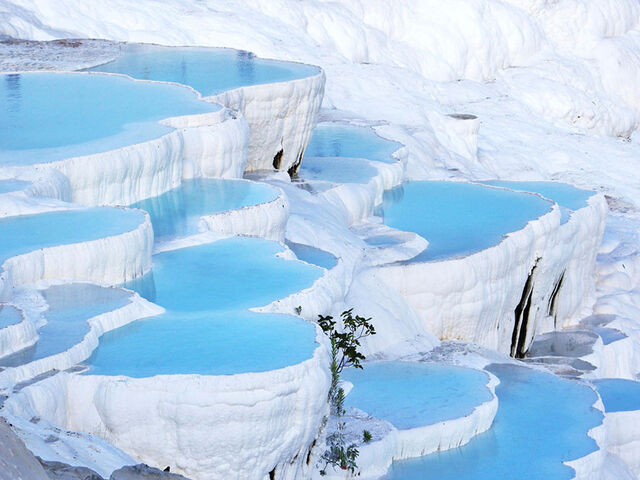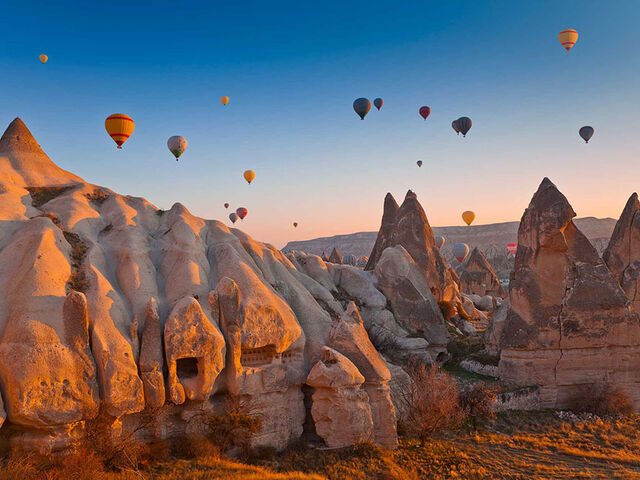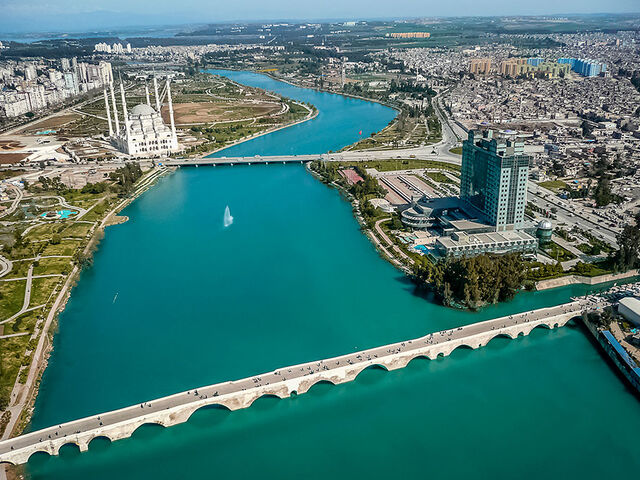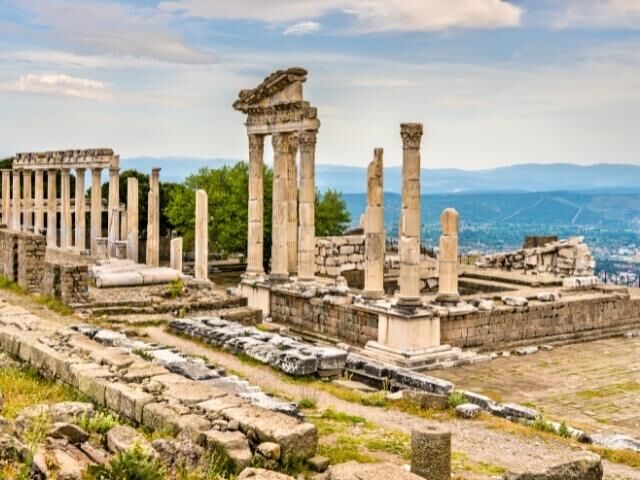
D1: Istanbul – Domestic Flight to Adana – Antoch
(only Lunch, Dinner ) Arrive at İstanbul Airport, fly to Adana by domestic flight and then drive to Tarsus, the birthplace of Saint Paul. In the pre Christianity period, Tarsus was known as the place Cleopatra tempted March Antonius after his victory in Philip When he ordered to get the Egyptian queen Tolemita to punish her because of her help to Casio When the engineers of the antic Tarsus opened a passageway in between the Nothern Mountains till the Cilician Gates, they created one of the most historical mountain routes of all the times. Till then the armies and the merchants used this passageway. Persians with their 100.000 people and later on Alexander the Great passed through here. Alexander the Great was almost losing his life while he was swimming in the freezing waters of the Cygnus River. Arrive at Tarsus and visit the well of Saint Paul and the Cleopatra Gate. Lunch in Tarsus and drive to Antakya ( Antioch ) overnight.
D2: Antioch
Breakfast and departure for Antakya, the biblical city called Antioch, situated next to the Asi ( Orantes) River in the fertile plains surrounded by the high mountains. This is the city where the Word “Christian “ was used for the first time. Its museum has one of the richest Roman mosaic collections in the World. The majör part of the fantastic stone paintings was found during the excavations in Antakya and around Daphne. Outside the city, there is the Cave of Saint Peter which was a church constructed in a cave where the apostles gave their first peach and where the Christian community settled down. Lunch during visits. Afternoon, drive to Samandağı, 25 km from Antakya, which is a resort town with a pristine beach. Seleucia Piera North of the town was founded around 300 B.C and by the time St.Paul and St.Barnabas made their first missionary journey here, it was a busy port. The most interesting monument to see is the Tunnel of Titus, built to divert rainwater.
D3: Antioch – Cappadocia
After breakfast, drive to Cappadocia. Today we visit the incredible Underground City of Kaymakli where early Christians lived secretly to survive and keep their faith. Picture stops will be given at the Valley of the Birds and the foot of the Uchisar Castle. Afterwards, Then proceed to the rock-carved churches hollowed out of volcanic ash.
D4: Cappadocia
Full day exploring Cappadocia. Visit Goreme Open Air Museum, Avanos, the pottery making town, the natural Citadel of Uchisar. Visit the Ihlara Valley which was formed by volcanic eruption where the Melendiz River flows to create this impressive canyon. Byzantine rock chapels covered with frescoes are built into the wall of the canyon. Stop by Carpet Weaving Center to view handmade Turkish Carpets.
D5: Cappadocia – Konya
Early morning we will drive to Pisidian Antioch (Yalvac) where St. Paul opened Christianity to the world. Yalvac's history goes back to 280 B.C. During St. Paul's time, the population was a mixture of Jews, Romans and Greeks. Very little is left of Pisidian Antioch today. There are the propylaea of the acropolis with several carved stones and the remains of a Byzantine church. Then we drive to Konya or ancient Iconium, which became an important Christian city following St. Paul's preaching. A Phyrigia legend says that Konya was the first city to be founded after the flood. St. Paul and Barnabas came here in 47 A.D. and their preaching was accompanied by many miracles. St. Paul made two more stops here on his second and third journeys. Today's Konya is quite new but the centre of the city is very old. Dinner and overnight
D6: Konya – Pamukkale
After breakfast, drive to Pamukkale to visit Hierapolis which was founded by Pergamon king Telephos and named after his wife Hiera. Most likely, the very large Jewish element in this city was an important factor in the rapid expansion of Christianity. During the Byzantine period, the city became the seat of the diocese with a large Christian Church dedicated to St. Philip, martyred here in 80 A.D. Highlights include the Roman Baths, the Temple of Apollo and the Theater. Then visit Laodecia. We find here two Theaters, a large Stadium, a Water Tower and an Odeon. The city is supposed to have been named by Antiochus II in honour of his wife, Laodicea. St. Paul wrote a letter to the church here(Acts:4:16). Dinner and overnight in Pamukkale.
D7: Pamukkale – Kuşadası – Ephesus -İzmir
214 KM After breakfast drive to Kusadasi. We go to Ephesus, the best-preserved and most visited city of all ages. It is as popular a religious shrine today as it was in ancient times. Revelation 1:11; 2:1-7; Acts 18:19-28; 19:1-41. The city was dedicated to the Goddess Artemis, whose temple is one of the Seven Wonders of the World. We tour the remnants: the majestic theatre, Arcadian, library of Celsus, marketplace, street of the Curetes, baths of Scholastica, agora, odeon. Next, we visit the House of Virgin Mary declared holy by the Vatican and St. John's Basilica. After lunch, drive to Izmir. Dinner and overnight in Izmir.
D8: İzmir – Smyrna – Sardis – Philadelphia – İzmir ( Smyrna )
Following breakfast, we visit Smyrna, one of the Seven Churches of Revelation. Drive to Sardis one of the Seven Churches of Revelation, visit the remains of the church which was built onto the Temple of Artemis and the earliest synagogue built in Asia Minor. After lunch, visit Philadelphia, one of the Seven Churches of Revelation Transfer to the hotel. Dinner and overnight.
D9: İzmir – Pergamum – Çanakkale
354 KM) After breakfast, visit the ancient Agora of Smyrna (Izmir). Then drive to the ancient site of Sardes with its temple of Artemis and ancient Synagogue. Then we go to Pergamon (Revelation 2:12-17), addressed by Saint John. We tour the remnants of Acropolis, its famous library, theatre, Athena, Dionysos, Trajan Temples. Drive to Canakkale. Check-in to our hotel in Canakkale for dinner and overnight.
D10: Çanakkale – İstanbul
360 KM)After breakfast at the hotel we proceed to Troy. Referred to in Homer's "Iliad" and "Odyssey", Troy has nine cities superimposed one upon another. Troy (Trojan horse) VI pertains to the famous Trojan War of Homer where the legendary heroes included Agamemnon, Achilles, Ulysses, and Nestor on the Greek side and Priam, Hector, and Paris on the Trojan side. We will begin our scenic drive down to Gallipoli, historically famous for being the site of many battles during WWI. Then we will cross the second strategic waterway, the Dardanelles, and land in Asia we will cross the second strategic waterway, the Dardanelles, and land in Asia. Transfer to hotel for dinner and overnight.
D11: İstanbul
After breakfast, we visit St Sophia Museum which was the former Roma Imperial Church. Then visit the Hippodrome. Visit Underground Cistern This cistern is thought to have been built after the Nika revolt in 532 AD. It was known as the Basilica Cistern during the Roman period, as there was a Stoa Basilica above the pre-existing one at the time. After the conquest of the city by the Ottoman Turks, it was forgotten of and nobody knew that it existed. Re-discovered in 1545, it was used to water the gardens of Topkapi Palace. Lunch at the local restaurant, after lunch, visit The Chora Church is considered to be one of the most beautiful examples of a Byzantine church. The church is situated in the western, Edirnekapı district of Istanbul. In the 16th century, the church was converted into a mosque by the Ottoman rulers, and it became a secularized museum in 1948. The interior of the building is covered with fine mosaics and frescoes. Then visit The Saint Antoine Church. Construction began in 1906 and the church was completed in 1912. Its architect, Giulio Monger, who was born in Istanbul, gave it an Italian Neo-Gothic style. Today it is Istanbul’s largest church with the busiest congregation and is run by Italian priests. Dinner and overnight in Istanbul.
D12: İstanbul Transfer to Airport
After breakfast, we visit Little Hagia Sophia is a former Eastern Orthodox church dedicated to Saints Sergius and Bacchus in Constantinople, later converted into a mosque during the Ottoman Empire. This Byzantine building with a central dome plan was erected in the 6th century and was a model for the Hagia Sophia, the main church of the Byzantine Empire. It is one of the most important early Byzantine buildings in Istanbul. We board our private boat for our Bosphorus Cruise. We disembark at Sariyer and have lunch at a local fish restaurant. After lunch, we visit Spice Market which is also called Egyptian Bazaar. Free time for shopping. We will have dinner at a local restaurant just before transfer to the airport.
 EN
EN






